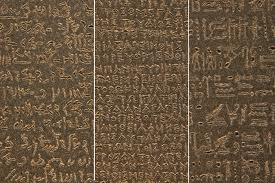Being semi-retired has it advantages. During the recent warm and sunny weather we took off to London for the day. The morning was spent looking around part of the British Museum and for the afternoon we got last minute tickets for the matinee of a stage show. This was followed by a walk round St. James’s Park and dinner. A good day with good company (my wife checks my blogs for English and so I have to say that).

The three languages on the rosetta stone
At the British museum we saw the famous Rosetta Stone. Just to remind you, it was the key to the decipherment of Egyptian hieroglyphs. The inscription on the Rosetta Stone is a decree passed by a council of priests. It is the same script in three languages, in hieroglyphic (suitable for a priestly decree), demotic (the native script used for daily purposes) and Greek (the language of the administration). This enabled the literal translation of hieroglyphics into their Greek equivalent and consequently into modern day language.
Another aspect of working part-time is to keep up-to-date and so I was listening to the Archers omnibus edition the following Sunday. The Rosetta Stone was mentioned in the context of enabling the truth to be deciphered. Bizarrely, this got me thinking about nitrogen recommendations for crops.
Nitrogen processes in the soil are fiendishly complex and Rothamsted is still researching the subject, despite nearly 170 years of endeavour. That is not meant to be a criticism but a way of demonstrating the complexity of the subject. Leonardo da Vinci wrote 500 years ago that ‘we know more about the movement of celestial bodies than about the soil underfoot’. Even today we would say ‘he was not wrong’.
No doubt there are variations in the soil processes between and within fields and perhaps within individual square metres of fields. So how do we get nitrogen doses correct with this type of background? The task is made even more demanding because weather after application will affect the amount of bag nitrogen required.
The reality is that recommended doses are often a long way off the mark. So the task in hand is to minimise these errors. The key is how should we do it? What is the equivalent to the Rosetta Stone for nitrogen application?
As many of you know, despite the complexity of nitrogen use in the soil and by the crop, many current recommendation systems are based on a simple model. The model is that Soil Mineral Nitrogen is used by the crop at 100% efficiency and fertiliser nitrogen is used at 60% efficiency. This sounds a bit odd to many: why the difference in efficiency, surely nitrogen is nitrogen?
I think the basis for the assumed difference in efficiency goes back to a time when there was more potential for mineralisable nitrogen in the soil. This was because arable land typically had a recent history of grassland and/or regular use of organic manures. One way to take this into account was to assume a high uptake of the measured Soil Mineral Nitrogen to ensure that there was an allowance for a significant amount of net mineralisable nitrogen during the season.
However, this is not now the typical situation. The vast majority of arable fields have no recent history of grassland or organic manure use. NIAB TAG trials over the last ten years suggest that the efficiency of use of Soil Mineral Nitrogen by wheat is way below 100% in long term arable soils where organic manures have not been used. As I have previously reported, in Australia, where the majority of nitrogen for the crop is from the soil, they assume an efficiency of uptake of 40-50%.
Why is this important? The assumption of 100% efficiency of Soil Mineral Nitrogen and 60% efficiency of bag nitrogen results in a reduced recommendation of around 1.67 kg/ha (100 divided by 60) of bag nitrogen for every additional kg/ha of nitrogen in the soil. Hence, if the efficiency of Soil Mineral Nitrogen is in fact significantly less than 100% then there is a danger of recommending sub-optimal levels of bag nitrogen. This is particularly relevant for long term arable soils with nitrogen indices of 2 and above in RB 209 and where there is no recent history of organic manures. This includes wheat after oilseed rape.
As I am a rather pragmatic part-time agronomist I consider that actual trial results, with all their shortcomings, are the Rosetta Stone for nitrogen recommendations. These indicate that nitrogen recommendations for wheat after oilseed rape in the current edition of RB 209 are still too low. Hence, I believe that the simple assumptions adopted in many recommendation systems have led to something being lost in translation.
By the way, I really do not see the Archers as being at the cutting edge of agriculture but what are the chances of building the super-dairy at Ambridge? In such a politically correct programme I suspect the chances are zero!
